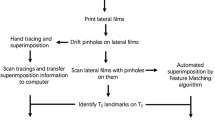Summary
The computer-aided method presented is able to interpret and measure radiological structures automatically and reproducibly on a large number of randomly selected lateral head films of different film quality. For example the hard and soft tissue expression of the profile is used to discuss method, application and disadvantages. The performance of the system depends on image quality. The algorithm cannot be influenced by opacifications due to metal structure. In 90% of all cases the contours are identified correctly. Even if the image quality is poor, the recognition rate is about 84%. The selected cephalometric landmarks are placed in the right way in 85% of all cases. The constraint mathematical conditions and the high reproducibility improve the quality process of the cephalometric analysis. Recognition rates of 84% to 90% justify even nowadays the routine use of semi-automatic systems in PC-based analysis. With advancing digital radiography and improved computer performance, image interpreting systems will certainly become established.
Zusammenfassung
Es wird ein computergestütztes Verfahren vorgestellt, mit dem erstmals an einer größeren Anzahl (n=103) zufällig ausgewählter Fernröntgenseitenaufnahmen mit unterschiedlicher Bildqualität automatisch röntgenologische Strukturen interpretiert und reproduzierbar vermessen werden können. Am Beispiel der Darstellung des Hart- und Weichgewebeprofils werden Methodik, Anwendung und Problematik besprochen. Die Leistungsfähigkeit des Verfahrens ist abhängig von der Bildqualität. Der Algorithmus zeigt sich stabil gegenüber metalldichten Störungen. In 90% aller Fälle werden die Konturen korrekt erkannt. Selbst bei schlechter Bildqualität liegt die Erkennungsrate bei 84%. Die ausgewählten kephalometrischen Meßpunkte werden zu 85% richtig identifiziert. Die Definition der Meßpunkte auf geometrisch-mathematischer Basis und die hohe Reproduzierbarkeit verbessern die Prozeßqualität kephalometrischer Auswertungen. Erkennungsraten von 84% bis 90% rechtfertigen schon heute den routinemäßigen Einsatz semiautomatischer Verfahren im Rahmen PC-basierter Auswertungsmethoden. Prognostisch ist anzunehmen, daß sich solche Systeme mit fortschreitender Entwicklung der digitalen Röntgentechnik etablieren werden.
Similar content being viewed by others
References
Adams JW, Correction of error in cephalometric roentgenogramms. Angle Orthod 1940; 10:3–13.
Baumrind S, Frantz RC. The reliability of head film measurements. I. Landmark identification. Am J Orthod 1971;60:111–27.
Broadbent BH. A new X-ray technique and its application to orthodontia. Angle Orthod 1931;1:45–66.
Brodie AG. Cephalometric roentgenology: history, techniques and uses. J Oral Surg 1949;7:185–98.
Cohen AM, Ip GC, Linney AD. A preliminary study of computer recognition and identification of skeletal landmarks as a new method of cephalometric analysis. Br J Orthod 1984;11:143–54.
Davis DN, Forsyth D. Knowledge-based cephalometric analysis: a comparison with clinicians using interactive computer methods. Comput Biomed Res 1994;27:210–28.
Davis DN, Mackay F. Reliability of cephalometric analysis using manual and interactive computer methods. Br J Orthod 1990;18:105–9.
Davis DN, Taylor CJ. A blackboard architecture for automating cephalometric analysis. Med Inf Lond 1991;16:137–49.
Downs WB. Variations in facial relationships: Their significance in treatment and prognosis. Am J Orthod 1948;34:812–40.
Forsyth DB, Davis DN. Assessment of an automated cephalometric analysis system. Eur J Orthod 1996;18:471–8.
Hofrath BH. Die Bedeutung der Röntgenfern- und Abstandsaufnahme für die Diagnostik der Kieferanomalien. Fortschr Orthodont 1931;1:223–8.
Housten WJB. The analysis of errors in orthodontic measurements. Am J Orthod 1983;4:382–90.
Levy-Mandell AD, Venetsanopoulos AN, Tsotos JK. Knowledge-based landmarking of cephalograms. Comput Biomed Res 1986;19:282–309.
Parthasarathy S, Nugent ST, Gregson PG, Fay DF. Automatic landmarking of cephalograms. Comput Biomed Res 1989;22:248–69.
SPSS/PC for the IBM PC/XT/AT. Statistical package for the social sciences. SPSS Inc., Chicago Ill., 1986.
Stamm T, Brinkhaus HA, Lenzen H, Bollmann F. Computergestützte Weichteilprofilerkennung im Fernröntgenseitenbild Dtsch Zahnärztl Z 1996;51:482–4.
Techovanich S. Die verbesserte Profildarstellung in der seitlichen Fernröntsgenaufnahme. Zahnmed. Diss., Münster, 1993.
Author information
Authors and Affiliations
Rights and permissions
About this article
Cite this article
Stamm, T., Brinkhaus, H.A., Ehmer, U. et al. Computer-aided automated landmarking of cephalograms. J Orofac Orthop/Fortschr Kieferorthop 59, 73–81 (1998). https://doi.org/10.1007/BF01340641
Received:
Accepted:
Issue Date:
DOI: https://doi.org/10.1007/BF01340641
Key Words
- Medical image interpretation
- Automated cephalometric analysis
- Digital image processing
- Head film measurements
- Quality assurance




